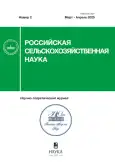Factors, influencing the contamination of spring wheat in the northern forest-steppe of the Southern Urals
- Authors: Shatalina L.P.1, Anisimov Y.B.1, Moshkina Y.S.1, Lopukhov P.M.1, Kalyuzhina E.L.1
-
Affiliations:
- Chelyabinsk Research Institute of Agriculture
- Issue: No 2 (2025)
- Pages: 11-15
- Section: Agriculture and land reclamation
- URL: https://journals.eco-vector.com/2500-2627/article/view/684079
- DOI: https://doi.org/10.31857/S2500262725020022
- EDN: https://elibrary.ru/DDYEDA
- ID: 684079
Cite item
Abstract
The study was conducted to determine the effect of predecessor, mineral fertilizers and weather conditions on the formation of agrophytocenosis of spring wheat using zero tillage technology. The object of the study is the weed component of agrophytocenoses and the activity of its influence on the productivity of spring wheat in the northern forest-steppe zone of the Southern Urals against the background of zero tillage technology. The experimental design was implemented in 3 crop rotation variants and a monoculture, with 6 predecessors of spring wheat, against two fertilization backgrounds: without fertilizers (0) and with the application of nitrogen fertilizers (N). With zero tillage technology, the litter component in spring wheat crops consisted of juvenile weeds in all experimental variants. Their number during sowing according to crop rotation variants significantly depended on the weather conditions of the year, in a waterlogged year, on average, the difference reached 27 units/m2, with a coefficient of variation of 47 %. The biomass of spring wheat was significantly dependent on the background of fertilization – on average, the differences over the years reached 72 g/m2. According to the predecessor of spring wheat, peas + oats, a higher mass of juvenile weeds was noted, compared with other predecessors, on average by 43…66 g/m2 in fertilization backgrounds. The specific mass of weeds significantly depended on the meteorological conditions of the year, with differences reaching 7 %. In dry years, the share of the influence of the number of annual weeds and the biomass of the crop on the productivity of spring wheat on a fertilized background reached 80–82 %.
Full Text
About the authors
L. P. Shatalina
Chelyabinsk Research Institute of Agriculture
Author for correspondence.
Email: chniisx2@mail.ru
кандидат сельскохозяйственных наук
Russian Federation, 456404, Chelyabinskaya obl., Chebarkul’skii r-n, pos. Timiryazevskyi, ul. Tchaikovskogo, 14Yu. B. Anisimov
Chelyabinsk Research Institute of Agriculture
Email: chniisx2@mail.ru
кандидат сельскохозяйственных наук
Russian Federation, 456404, Chelyabinskaya obl., Chebarkul’skii r-n, pos. Timiryazevskyi, ul. Tchaikovskogo, 14Yu. S. Moshkina
Chelyabinsk Research Institute of Agriculture
Email: chniisx2@mail.ru
Russian Federation, 456404, Chelyabinskaya obl., Chebarkul’skii r-n, pos. Timiryazevskyi, ul. Tchaikovskogo, 14
P. M. Lopukhov
Chelyabinsk Research Institute of Agriculture
Email: chniisx2@mail.ru
кандидат сельскохозяйственных наук
Russian Federation, 456404, Chelyabinskaya obl., Chebarkul’skii r-n, pos. Timiryazevskyi, ul. Tchaikovskogo, 14E. L. Kalyuzhina
Chelyabinsk Research Institute of Agriculture
Email: chniisx2@mail.ru
Russian Federation, 456404, Chelyabinskaya obl., Chebarkul’skii r-n, pos. Timiryazevskyi, ul. Tchaikovskogo, 14
References
- Чевычелова Н. В., Жаркова С. В., Шевчук Н. И. Приемы агротехнологии на посевах яровой пшеницы и их влияние на рост и развитие растений // Вестник Алтайского государственного аграрного университета. 2024. № 4(234). С. 38–44.
- Продуктивность и рентабельность льна масличного в зависимости от погодных условий и технологии выращивания в условиях засушливого земледелия / К. А. Акшалов, М. Б. Кужинов, О. Н. Баймуканова и др. // Вестник науки Казахского агротехнического университета им. С. Сейфуллина. 2023. № 1–1(116). С. 196–211.
- Фисунов Н. В., Шулепова О. В., Фоминцев А. В. Засоренность и урожайность яровой пшеницы в условиях лесостепной зоны Зауралья // Вестник Мичуринского государственного аграрного университета. 2021. № 4 (67). С. 54–58.
- Скороходов В. Ю., Зоров А. А Особенности влияния парового поля на формирование агроценоза и продуктивность яровой пшеницы в полевых севооборотах региона с неустойчивым увлажнением // Российская сельскохозяйственная наука. 2021. № 5. С. 3–8.
- Горянин О. И., Щербинина Е. В. Совершенствование технологии возделывания яровой пшеницы в Поволжье // Аграрный научный журнал. 2020. № 6. С. 11–14.
- Малышкин Н. Г. Оценка видового состава растений рудеральных и сегетальных местообитаний Аромашевского района Тюменской области // Вестник КрасГАУ. 2022. № 2(179). С. 29–34.
- Шаталина Л. П., Анисимов Ю. Б., Калюжина Е. Л Ассоциации сорных растений в агрофитоценозах яровой пшеницы // Российская сельскохозяйственная наука. 2020. № 2. С. 25–29.
Supplementary files











